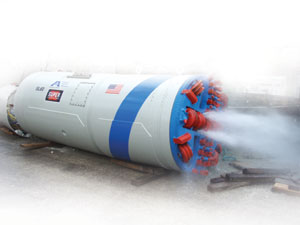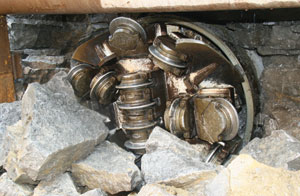Listening to the Earth
 Does anyone need to listen to music while they jog? What did people do before 60-in. plasma televisions illuminated their lives? It’s nice to think that we live in a consumer-driven society, but by and large, ours seems more product-driven than anything. A team of researchers cooks up a nifty little gadget and hands it over to marketing, which in turns spends truckloads of money convincing consumers that something they might want is actually something they need.
Does anyone need to listen to music while they jog? What did people do before 60-in. plasma televisions illuminated their lives? It’s nice to think that we live in a consumer-driven society, but by and large, ours seems more product-driven than anything. A team of researchers cooks up a nifty little gadget and hands it over to marketing, which in turns spends truckloads of money convincing consumers that something they might want is actually something they need.
Not every industry can operate this way. Microtunneling boring machine (MTBM) manufacturers operate on a fairly simple through line: The soil tells the contractor and manufacturer what kind of MTBM is needed. The manufacturer meets that need. End of discussion.
MTBMs and their larger cousins have always been designed to accommodate a particular job and a particular drive. To be sure, specification for microtunneling has always depended on the conditions in which the drive is needed. Innovations have typically been driven by the work, rather than the other way around.
“The stuff we’re doing now could have been done 10 years ago if we had gotten the kind of soil reports we get now,” says Rob Tumbleson, vice president of sales and marketing for Akkerman Inc., which is based in Brownsdale, Minn.
Paul Nicholas, general manager of the SBU Division at The Robbins Co., agrees. “The machines haven’t changed much over the past 10 years,” Nicholas says. “The application has changed as geological baseline reports allow machines to be more closely fitted to the particular conditions.”
According to Tumbleson, contractors and owners were reluctant to spend money on thorough soil reports before the machine was in the ground. “They would just cross their fingers and hope for the best,” he says. If soil conditions changed dramatically as a drive progressed, a change-order would be created and adjustments made.
Owners have come to realize that they will spend money on the soil one way or another. While a detailed soil analysis adds money up front, failing to perform such an analysis can burn through funding rather quickly. If an MTBM in the ground runs into trouble, the machine must be pulled back to the last jacking pit and the soil ahead examined to determine the cause of the problem. Such a work stoppage carries a financial impact, as does the cost of on-the-fly MTBM changes, as well as the increased wear on machines as cutter faces pushed into ground for which they were ill-equipped. Not only that, if enough stoppages occur and project delays overrun the contract, the contractor will likely face claims and more potential lost revenue.
“The ground hasn’t changed,” explains Tumbleson. “We know how to work in different soils. The difference is that now we’re getting information up front about what the machine will face. With that information, we can better equip the machine to tackle the conditions at hand.”
For example, Tumbleson describes an in-the-works project in Milwaukee with an initial drive through hard rock before finishing up in soft ground. Knowing where the soil will change dramatically means he can plan for an MTBM face-change in advance rather than having the contractor scramble around while work is in progress.
 Another example of a project-driven MTBM innovation occurred on an earlier job in Milwaukee. Typically, the 6,000-lf drive through dry clay would not have been a good fit for microtunneling, but the contractor needed the back end of the job to finish with an MTBM. Akkerman considered the soil conditions and made key changes to its machine, increasing the high-pressure jetting and rpms to deal with the dry clay, to making the crushing cone steel thicker to deal with the increase in cobbles the machine would meet. This MTBM was fitted outside of what would be “normal” specs, but given the appropriate information, Akkerman’s team was able to meet the conditions face-on.
Another example of a project-driven MTBM innovation occurred on an earlier job in Milwaukee. Typically, the 6,000-lf drive through dry clay would not have been a good fit for microtunneling, but the contractor needed the back end of the job to finish with an MTBM. Akkerman considered the soil conditions and made key changes to its machine, increasing the high-pressure jetting and rpms to deal with the dry clay, to making the crushing cone steel thicker to deal with the increase in cobbles the machine would meet. This MTBM was fitted outside of what would be “normal” specs, but given the appropriate information, Akkerman’s team was able to meet the conditions face-on.
To quantify how microtunneling has improved with better soil studies, Tumbleson points to reports from contractors in terms of how often they have to stop and retrieve machines in distress. “When I started in microtunneling in 1990, the typical contractor would complete three or four drives successfully before a stoppage,” he says. “Recently, we had a contractor report 41 consecutive completed drives between stoppages. That would have been unheard of before.”
The Robbins Co., known worldwide as a premier TBM manufacturer, has made strides to bring big-bore technology to smaller drives. The Robbins Small Boring Unit (SBU) is specifically configured for hard rock, Robbins’ specialty. By sporting the same cutterhead configuration as is found on larger Robbins TBMs, SBUs have been used successfully on hundreds of jobs across the United States. With patented mini disc gage cutters, Robbins machines thrive in hard rock just as their bigger siblings do.
“Another factor that has driven the market has been the improvement in pipe used,” says Nicholas. “As pipe has become stronger at a given diameter, drives can go longer and through more solid ground conditions.”
Nicholas notes that the more run-of-the-mill microtunneling applications (a standard gravity sewer install for example) typically don’t bring forth many changes. The single-drive or one-off crossings that are either very deep, very long or through particularly hard rock are where innovations take place. “Those are the jobs we all read about. It looks that that’s what everyone is doing, but those applications are not the majority of the market.”
“Microtunneling is in a lot of ways about problem-solving,” says Tumbleson. “Innovations are driven by the specific needs of a particular job, by the soils.” As more and more contractors and designers witness the adaptability of microtunneling and turn to manufacturers like Akkerman and The Robbins Co. to push into challenging ground conditions, microtunneling will continue to bore its way into the hearts and minds of trenchless construction professionals.
Greg Thompson is an assistant editor of Trenchless Technology.
